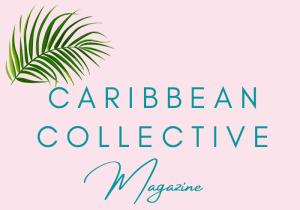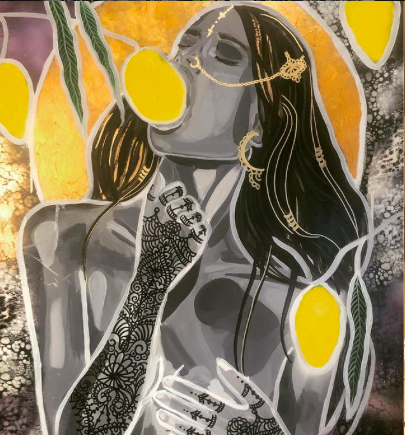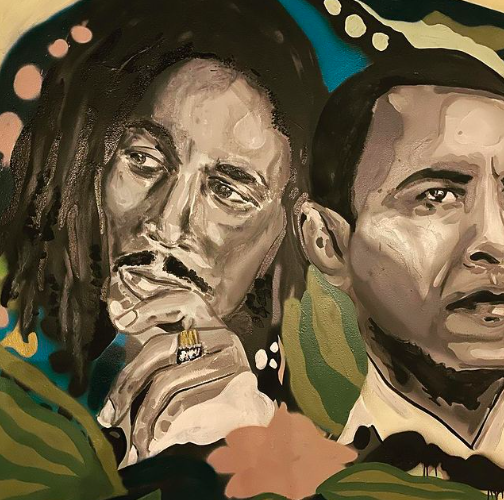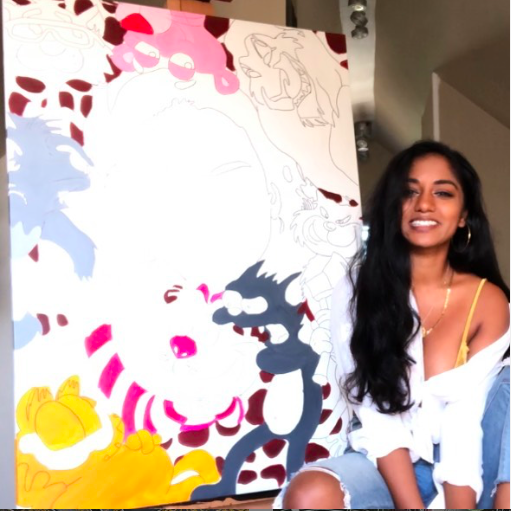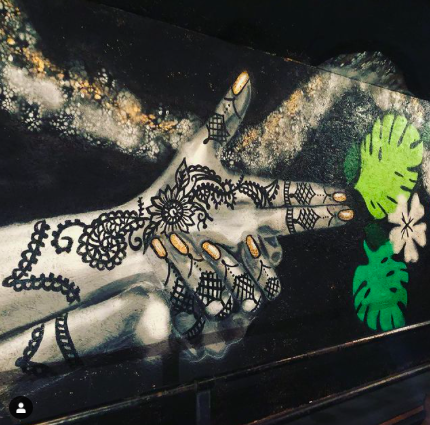Amrisa Niranjan: New York’s Only Female Indo-Caribbean Muralist
photos courtesy of artist Amrisa Niranjan
written by Cassy
Within Caribbean culture, there is no shortage of creatives. From Dancehall artists, to illustrators, to makeup up artists, our small but impactful region touches all art forms. Many West Indian womxn stay connected to culture within a hyphenated identity, through art, and the ability to dance to the rhythm of music genres like reggae, soca, and calypso.
I was pleasantly surprised to learn about New York-based Indo-Caribbean painter and muralist Amrisa Niranjan. While there are a slew of West Indian artists, rarely do I come across well-known or mainstream Indo-Caribbean womxn artists.
Niranjan has created a name for herself on the New York City scene. One of most popular pieces includes “Gyal Dem,” a mural and installation done for the famous Negril Village restaurant. The mural features a diverse group of Caribbean womxn with subliminal hints of West Indian culture scattered throughout the piece.
“…I wanted to create a work that celebrated that inclusiveness, and in this piece, I wanted to celebrate Caribbean women. In these faces, the women are rising out of water. Around them are things such as flowers, the ackee fruit, the conch shell, and of course, a mango. I hope, if you ever see this piece, you feel that the spaces that welcome you in, are reflecting beauty and diversity. That the level of work in the spaces that welcome you, is beautiful. That your moments in life are going be beautiful, and that you have a place in the world where your ancestry is honored and celebrated. I hope you feel all the energy, reggae, soca, and Afrobeats I played while working on this piece. While some of us fight for justice for the dead, I want to continue, through art, crafting spaces that provide integrity and a level of work to influence the joy we can feel while living.”
Gyal Dem by Amrisa Niranjan
In perusing her artwork, Niranjan alludes to much of her influence coming from Caribbean music. Her painting of Dancehall artist Popcaan is a prime example.
“All my life I have listened to dancehall and reggae and loved it because it reminded me of the Caribbean, of my culture. It’s raw. It’s funny. It’s great to dance to. But like a lot of music there were times the words, were not right to me, times where it seemed like the whole song was about a man proving he was a man via some narrative of violence, dominance of women, money, and whatever makes people believe your d*ck is bigger, I suppose. It’s not a far reflection of a dying male culture overall. But I noticed in the last few years, not in all the guys, but in so many of them, that something maybe seemed to shift away from that. And I realized maybe the time has come for boys not just to be allowed to share self expression, but to be appreciated more for the expression, encouraged to feel, and be made to understand strength and love are not binary but in fact exist together. The Popcaan music album caught me off guard because it was about so much love, I was almost confused at first. But I loved it. It’s probably my favorite album of his so far.”
Where We Come From To Forever 26 X 26 Acrylic On Wood, 2020 by Amrisa Niranjan
Although popular amongst West Indians, music and the performing arts are not the only form of expression and inspiration. Niranjan spoke who spoke to CC Mag about her experiences and cultural influences as an Indo-Caribbean artist.
Where would you say your motivation/inspiration derives from?
“My motivation for art has always been intrinsically driven, I have been doing it since I was a child. It is not something that was kicked-off from social or political events. I was creating content before I could write. The need to create art has always been something I wanted to do, when I was younger I would type on my mother’s keyboard just to feel like I was creating content. The types of art I do may be motivated by different things but the need to create fine art and visual art is innate and 100% something within myself. I couldn’t kill it if I tried.”
[Additional Read: Meet Dominica’s Samantha Moon]
You spoke about getting inspiration for your different pieces of art. Where do you find the inspiration for them?
“It really does depend on the piece itself. A lot of my artwork pieces are portraitures, so you can say they are driven by contemporary experiences. In the past, it was driven by identity. Currently however, I have shifted away from identity-driven artwork and explore beyond that. I felt that as an artist I have explored identity to my satisfaction as far as immigration, indentureship, and ‘Indo-Caribbean-ness.’ Then I had to figure out what was next. More and more I found myself diving into the contemporary experience of myself and my peers. The motivation changes according to the place where I’m at mentally. I am currently in the contemporary experience which does include my identity as an Indo-Caribbean woman, a millennial, my minority background. My art feeds into it but it is not focused just on my identity like my previous pieces were.”
“When I’m creating my pieces, you can call it an exorcism. I may not know what I want to create or what the meaning of the piece I’m creating has, but once I begin and my work it’s on the canvas, it’s out there. I know exactly what I want it to be and what it means. It doesn’t mean the artwork is a manifestation of my ‘demons’ but the process by which they come out typically tends to be similar. For example, one of my pieces that was created like that was called ‘Known.’ Ethnically it looks like a racially South Asian / East Indian woman with mangoes around her. It was very identity driven but when I was creating her, it felt like an exorcism and as creating her. I felt so much weight lifted off my shoulders. I was contemplating indentureship when creating her and how generations of people lived and died in the name of indentureship. However, they weren’t just indentured servants. These people lived lives, formed relationships and their status does not completely define them. But because of them, I as well as many of my Caribbean peers live the life we live and I just wanted to say ‘thank you.’ ‘Known’ was about recognizing them and honoring them for their sacrifices to make my life possible. One of the last pieces of the woman in ‘Known’ was her bindi. Before the bindi, people did not understand that she was from an Indian background but once I placed the bindi on her there was no question of her ethnicity. I have never had an art experience like that before and it was absolutely amazing and cathartic for me.”
Do you feel like there is a lack of visual artists/fine arts artists in our community? And if so, why?
“I feel like they maybe do exist but I have not crossed paths with them as yet. When I was working on my first art show I could not find any Caribbean women who have conducted this type of art. I learned then that I had to be the person I was looking for. But then I came across a group but they were from over two decades ago and they were not women. I believe we are growing together. I am learning that we are all having this surge together. I don’t believe they didn’t exist, they just weren’t documented like other artists were.”
“I also believe there is an economic stand point we must consider when worrying about our bottom line. Most of our ancestors were cane cutters that focused on surviving. It does not mean they did not like art, or appreciated art; the reality is a painting is beautiful but they don’t feed our families. Obviously, they appreciated art we had Bollywood movies, jewellery, architecture, clothing, and henna. It may not be in the contemporary way that we think of art, but I would never do a disservice to our generations who grew up in indentureship. They built a platform for us to eventually get back to it, but I am against people saying there is a significant unappreciation for the arts. It may carry from family to family but again there is this innate mind-set of surviving. However, our generation is finding that we can survive, thrive and indulge in our appreciation of the arts whether performing, fine or visual arts.”
“The ability to pursue arts in our culture is a privilege, because imagine having kids at a young age, having to maintain a home, work on your poetry and seek out publishers? That is a lot and because of the efforts of those who came before us people like me can work on my art and still maintain a 9 to 5 job”.
That was incredibly said! Are there any last thoughts you would like to leave our readers with?
“Appreciate. Respect. Recognize and always honour your identity BUT you are not limited by it. When you see someone who just looks like they’ve had it easier, do not be discouraged but be encouraged by that. Be encouraged on the days you are working yourself to the bone. Do not look to others and see their progress and compare it to yourself. I don’t limit myself to just telling the stories of indentureship or Indo-Caribbean culture, as an artist I am free to tell stories beyond that. I have honored my culture but I think if I was two or three grandmothers back I would be proud to see my descendent not constantly defining themselves by the struggles I and the rest of their ancestors have gone through. Instead, I’d be proud of seeing them go forward and live.”
“Also, don’t be afraid to say you are willing to learn. A million people will say ‘no’ to teaching you. But one person will say yes and it will surprise you at what you can learn and do. You can find mentors in the strangest places”.
Here at Caribbean Collective Magazine we strive to build a platform of representation of West Indian womxn from diverse backgrounds. Niranjan leaves us inspired, hopeful, and with a desire to learn about more Caribbean artists, some of whom we didn’t even know existed.
To learn more about Niranjan’s work visit www.amrisaniranjan.com.
